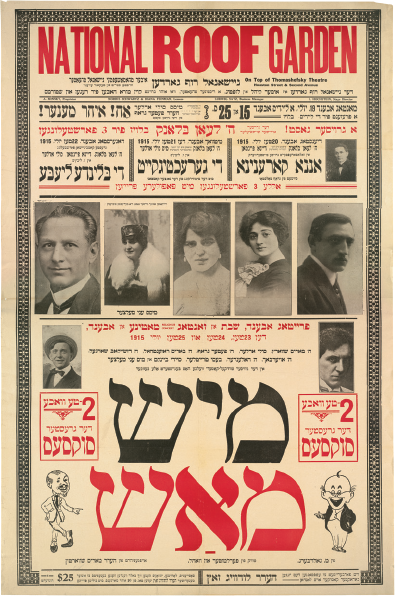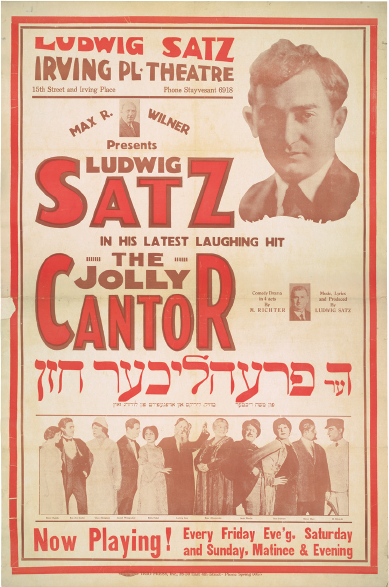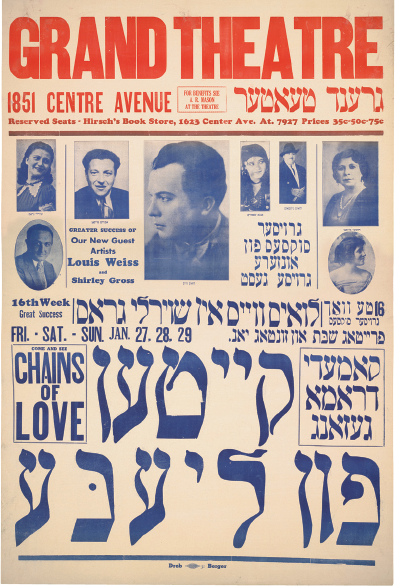Nahma Sandrow
Music has always played a key role in Jewish religious and communal life, both within and outside the synagogue. Long before there was a Yiddish theater, the carnivalesque holiday of Purim—the only time during the Jewish calendar year when masquerading is permitted—stood out for its rich use of music and performance. Professional and quasi–professional musicians were often employed in wedding celebrations as well. In fact, singers and instrumentalists were the only performers who received at least some professional training in traditional Eastern European Jewish communities.
These musical traditions carried over into the early days of the Yiddish stage. Some cantors provided music for the nascent Yiddish theater, while others went further, adding to their liturgical duties stage and even film careers. Yiddish operetta composers like Louis Friedsell (1863–1923), Herman Wohl (1877–1936), Sholom Secunda (1894–1974), and Joseph Rumshinsky (1881–1956) had musical roots in the synagogue and were equally at home composing for both the synagogue and the Yiddish stage. And many of the early stars of American Yiddish theater—including Boris Thomashefsky, David Kessler, and Sigmund Mogulesko—began their careers as meshoreyrim (plural of meshoyrer, a choirboy who accompanies the cantor), training in the service of famous cantors, and were thus singers prior to becoming actors.
These traditions had their roots in the decades leading up to the birth of Yiddish theater. By the middle of the 19th century, as Eastern European Jewish life began to urbanize and become more secular, music proved to be the least objectionable form of performance for traditional Jews because of its nonrepresentational nature and its all–male identity. It was thus natural that the first modern professional Jewish performers would be itinerant musicians. The first such group, the Broder Singers, originated, as their name indicates, in the Polish town of Brody. They were café singers who entertained their mostly working–class audience with songs, poetry recitations, and sketches, at times even introducing bits of dialogue and using makeup and props to add dramatic flavor to their numbers. Their success encouraged other musicians, and the term “Broder singers” assumed a generic meaning.
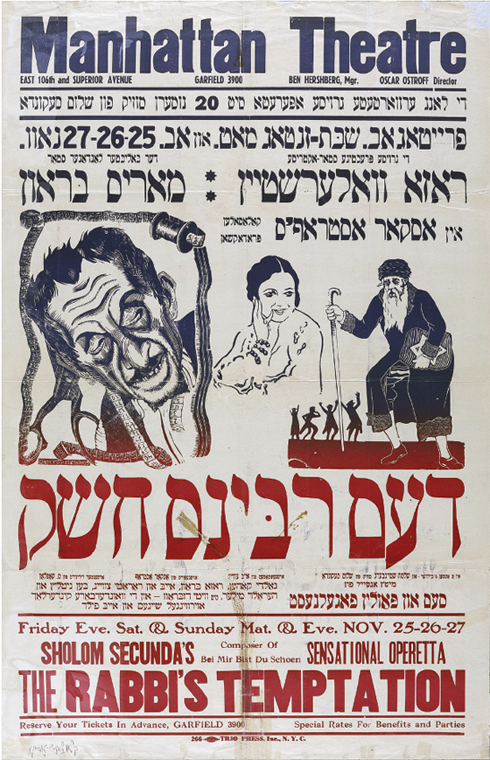
Poster for The Rabbi’s Temptation at Manhattan Theatre located at East 106th Street and Superior Avenue, 1932.
Music by Sholom Secunda, book by Sholem Steinberg. This “Hassidic” operetta starring Aaron Lebedeff and Leon Blank was first produced in 1924–25 at the Parkway Theatre. It was revived in 1933 and 1936.
The Yiddish theater came into being when a literary man and two singer/performers joined forces and created a new form of Jewish entertainment. The year was 1876, on the eve of the Russo–Turkish war. The place was Shimen Marks’s wine garden in the town of Jassy, Romania. In comes writer Abraham Goldfaden (1840–1908), a child of the Haskala (Jewish enlightenment), who had already made a name for himself as an author of popular songs. Goldfaden was hoping to establish a newspaper, but instead he joined forces with a couple of folksingers who were then performing at the local tavern, and provided a skimpy storyline that offered narrative continuity to their musical numbers. The moment was right: the public was thrilled, and soon the multitalented Goldfaden was heading his own traveling theatrical company, for which he functioned as producer, playwright, director, composer, and librettist. His early offerings resembled commedia dell’arte, with their combination of an uncomplicated, fixed scenario with improvised dialogue and stage business. But he soon grew into lavish operettas, some of which—The Witch (1879), The Two Kuni–Lemls (1880), and Shulamith (1880)—became beloved classics of the Jewish stage. The tales were simple, adopted from a variety of Jewish and European sources, with a musical hodgepodge of adapted cantorial tunes, Eastern European folk songs, German and French marches and waltzes, and melodies lifted from Mozart, Halevi, Meyerbeer, and Verdi.
In his magisterial Jewish Music: Its Historical Development, musicologist Abraham Z. Idelsohn (1882–1938) addresses what he terms the “motley origin” of Goldfaden’s music. He offers a close analysis of the music of two Goldfaden operettas, Bar Kokhba and Shulamith, and shows how the 17 musical numbers in the latter derive from a variety of specific sources: four cantorial pieces, four Jewish folk and Hassidic melodies, three operas, and the rest from Polish, Ukrainian, and Russian songs. While Idelsohn notes that Goldfaden’s contemporary enthusiasts had no musical education and were likely unaware of the songs’ derivativeness, he concludes that the tunes resonated with the audiences: “Though Goldfaden cannot be credited with original creations of music in these two operettas analyzed, he showed much dramatic skill and musical taste in adopting fascinating tunes which would appeal to the Jewish masses.”1 Interestingly, he made these adaptations without direct access to written sources: while Goldfaden had an excellent ear for music, he could not read it. Joseph Rumshinsky, a major conservatory–trained Yiddish composer, recounted that when Goldfaden needed music for a play, he would pick a cantorial musical score and ask a meshoyrer who could read music properly to sing it to him so that he could choose the sections that suited his authorial purposes.2

Sheet music for The Jewish Yankee Doodle, 1905.
Musical comedy by Boris Thomashefsky, music by Louis Friedsel.
Sheet music for “Eli, Eli, Lomo Ozavtoni,” 1907.
This popular song of the Yiddish repertoire opens with the lament from Psalm 22:1, “My God, my God, why hast thou forsaken me?” It made its debut in the operetta The Hero and Bracha or the Jewish King of Poland for a Night (1896), by Moyshe Hurwitz with a musical score by Jacob Sandler (1860–1931) and lyrics by Boris Thomashefsky. “Eli, Eli,” which was originally sung by Sophia Karp (1859–1904), gained universal renown after it was recorded by vaudeville superstar Belle Baker. In November 1921, the anti–Semitic Dearborn Independent vilified the song, calling it “a racial war cry.” It went on to say, “In the low cafés of New York, where Bolshevik Jews hang out. …It is constantly heard…where emotional Russian and Polish Jews—all enemies to all government—shout the words amid torrential excitement. When you see the hymn in print you are utterly puzzled to understand the excitement it arouses.”
According to some contemporaneous accounts, Goldfaden began the process of writing an operetta with the score, not with lyrics. Cantor Abraham Frachtenberg, who met Goldfaden as a young man in Romania, recalled years later their collaboration when the dramatist asked him to write music for Akedas Yitkhok (The Sacrifice of Isaac), a script he was working on. Goldfaden asked for a romantic musical piece, then a lullaby, and then for a love duet. Piece by piece, the score was completed. Only then did Goldfaden add words to the music.
Goldfaden’s early storylines may have been thin and the melodies borrowed, yet there was genius in the fresh and often–fantastic concoctions of this Yiddish bard. The people loved his tales and hummed his songs at home and in their shops, and the names of some of his characters—Schmendrik, Bobbe Yachne, and Kuni Leml—entered the Yiddish language as familiar folk types. His success encouraged the formation of competing itinerant troupes, and in a world with little regard for copyright, his work was soon imitated and plagiarized throughout the Yiddish–speaking world. When popular professional Yiddish theater arrived in America with the start of the mass immigration from Eastern Europe, its first production, in New York City, was The Witch, a Goldfaden operetta.
By the turn of the century, New York Yiddish audiences could see a great range of plays. The favorites were operettas, musical comedies, and melodramas with musical underpinnings. Though these plays were sometimes an absurd jumble of implausible incidents, the audiences were nonetheless pleased. Practically all plays included music, now influenced by operas and operettas more often than by more traditional sources. During the so–called Lateiner–Hurwitz period, for example, an aria from Tchaikovsky’s 1890 opera The Queen of Spades was used in Joseph Lateiner’s Destruction of Jerusalem, and the music composed by Edvard Grieg in 1875 for Ibsen’s play Peer Gynt was employed in its entirety in Lateiner’s 1893 operetta Bas Sheva. In 1885, in a review of Lateiner’s historical operetta Alexander, Crown Prince of Jerusalem, the critic for the New York Sun wrote:
The music vivif[ied] even the dullest portions…a melodious monody which swells sometimes into a chorus of tearful and tender lamentation…quaint, eloquent and touching, full of heart and feeling…lifts up both play and players and creates an illusion stronger than would be possible by the most deft arrangement of ordinary dramatic materials.
Goldie Awards presented to actress Mina Bern and choreographer Lillian Shapero, c. 1985.
Conceived as the Yiddish version of the Tony Awards, the Goldies were named for Abraham Goldfaden and bestowed by the World Congress for Jewish Culture from 1985–87 for contributions to Jewish art and theater. The first awards were presented to such greats as Molly Picon, Pesach Burstein, Miriam Kressyn, Seymour Rexite, Zvi Scooler, and Joseph Buloff.
These early operettas offered purely escapist entertainments: singing, dancing, romance, laughs, and spectacle. In the late 19th and first decade of the 20th century, the predominant public taste was for large costume operettas. Ancient Judea, the Golden Age of 15th–century Spain, and the courts of sultans and emperors all offered juicy opportunities for pageantry and lofty bombastic speeches delivered in the stiffly Germanic Yiddish known as daytshmersh. Such plays, whether based on biblical incidents, history, or on entirely fantastical creations, romanticized past Jewish glories. Characters were aristocratic or brave. If there were martyrs, they suffered nobly. These portrayals enabled audiences to feel pride in their identity. For newly arrived immigrants, it was glorious to watch Jews wearing golden robes and crowns and speaking Yiddish with crushing dignity.
The range and tone of Yiddish melodramas is evidenced by the varied titles of the best–known works of the genre. Joseph Lateiner’s (1853–1935) more than 80 works include such titles as Ezra; or, The Eternal Jew; Blumele; or, The Pearl of Warsaw; Mishke and Moshke: Europeans in America; and Satan in the Garden of Eden. His primary rival, self–proclaimed “Professor” Moyshe Hurwitz (1864–1910), was equally productive, with an oeuvre that contained such titles as Tisa esler (a docudrama); Monte Cristo; Elijah the Prophet; or, Millionaire and Beggar; and The Gypsy Woman. Nokhem Meyer Shaikevitch (also known as Schomer, 1849–1905) dramatized many of his own novels, including The Coquettish Ladies; The Jewish Prince; The Unfaithful Wife; or, The Bloody Idea; and The Second Haman.
Many of these plays, though often fantastic in plot and setting, dealt with issues important to the immigrant community. Take, for instance, Lateiner’s Dos yidishe harts (The Jewish Heart, 1908), which ran for several hundred consecutive performances—an extraordinary hit. The play deals with anti–Semitism, intermarriage, and the strength of familial bonds. It tells of Yankev (Jacob), a Jewish art student in Romania, who has won a prize for a painting, thus angering his archrival, the anti–Semitic Christian Viktor Popeska. Act I ends as Yankev discovers that Madame Popeska, Victor’s mother, is actually his own mother as well. It turns out that she abandoned baby Yankev and his late father when she ran off to marry her Christian lover. In Act II, we are told that, according to a new edict, Jews must have their parents’ signatures in order to get a marriage license. Yankev wants to marry Dina, so he contacts Mme. Popeska. She and her newfound son embrace. However, Viktor, horrified by the revelation, as well as by the damage that her public acknowledgment of Jewish blood will bring to him, confronts Yankev and threatens him with a gun. Torn between her two loyalties, the weeping Mme. Popeska refuses to sign, and the curtain falls on Jacob’s declaration that “We remain strangers.” In Act III, Yankev and Dina have decided to immigrate to America and marry there, but Yankev becomes sick. Mme. Popeska visits him in his sickbed and confesses:
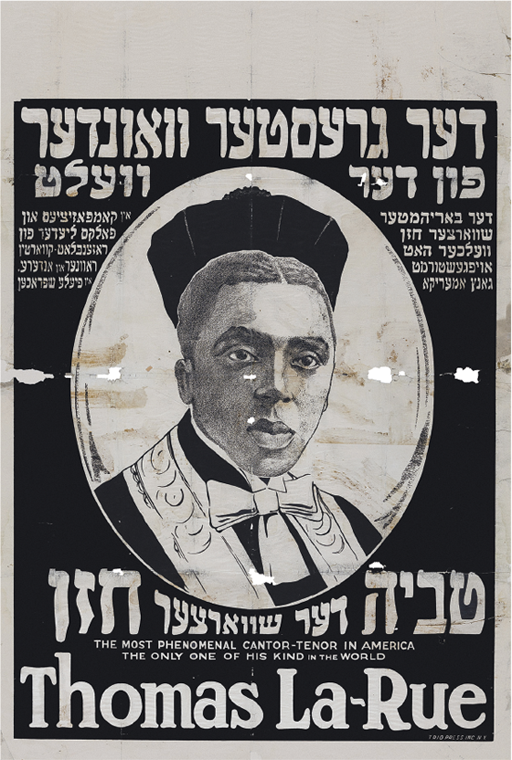
Poster for Thomas La–Rue as “Tevya, the Black Cantor,” 1920s.
The Yiddish text reads: “Tevye, the Black Cantor”; “The World’s Greatest Wonder!”; “The famous cantor who has taken America by storm in compositions by Rosenblatt…” Thomas LaRue, who was not Jewish, began his Yiddish career in the successful musical comedy Yente Telebende, produced in 1917 at Boris Thomashefsky’s National Theatre. In 1920, LaRue appeared on the cover of sheet music for “Ferlir nur nit dein hofnung reb Yid” (“Do Not Lose Your Hope, Dear Jew”), by Isidor Lash and Sholom Secunda, as “Thomas LaRue Jones,” the song’s “exclusive interpreter.” It must be around this time that he began to perform cantorial music wearing ceremonial garb. Throughout the 1920s and ’30s, LaRue performed across America, and appeared on radio programs, where he was listed as “the colored cantor.” The theatrical novelty of a gentile black singer performing cantorial music must be seen within the context of the synergy between the Yiddish stage and synagogue music. It also reflects the show–business star status enjoyed by America’s great cantors, who were also recording artists and offered cantorial concerts in secular venues.

Poster for Such is Life at the Yiddish Folks Theatre on Second Avenue at 12th Street, c. 1935
Poster for I Long for Home at the Satz and Rumshinsky Public Theatre, 1931.
Poster for Mish Mash at the National Roof Garden, 1915.
Poster for The Jolly Cantor at the Irving Place Theatre, 1925.
Poster for Chains of Love at the Grand Theatre, 1933.
MADAME POPESKA: Thank God. Yankev, you know the power of love and you will understand me. When I married your father, I was a child, fifteen years old. I didn’t marry him for love. My poor parents pressed me to become a rich man’s wife. Three years later, chance brought me together with my present husband, and then I, too, loved, as only an eighteen–year–old loves for the first time in her life. I sacrificed everything for him, for the emotion of my first love bewitched, enchanted me. I acted without thinking, without considering. When I grew older, the first enchantment passed. With time I recalled more and more strongly my own dear ones whom I had left behind me in my Jewish home. (Trembles.) Most of all I recalled my child, whom I left behind in the cradle. Ah, how often a burning longing came over me, and like a madwoman I wanted to run out into the world, run and find my child. But by then I was already also the mother of my two Christian children, and they too still lay in their cradles. (Weeps.) And this mother–heart of mine was torn in two. I did not know whom to sacrifice, or for whom. No one can imagine how I suffered in silence. Years passed, and the picture of my Jewish child did not fade, until chance brought you to me as a grown man. (She kneels.) Yankev, this sinful woman kneels before you, as before her judge. Hand down your verdict on your sinful mother. Demand the hardest sacrifice from me, and I will do it gladly, only let me be your mamma. You are a Jewish child with a Jewish heart—have mercy on your unhappy mother and forgive her, forgive her. (Kisses his hand.)
YANKEV: (After a strong inner struggle, presses her to his heart.) Mother!
Shortly after this act of forgiveness, Viktor bursts into the room with a revolver and, after spouting anti–Semitic slurs against his brother, there is a struggle and the revolver goes off, killing Viktor. In an act of redemption, Mme. Popeska saves her son from jail by confessing to the murder.
Act IV takes place at Yankev and Dina’s wedding. Mme. Popeska, though under arrest, is allowed to attend. At the end of the ceremony, she prays for the Jewish husband whom she abandoned in her youth, and, overcome, she dies. Yankev sings a reprise of a song, “Always remember your mother’s song.”
Onstage, well–acted, this was enormously effective. Moreover, in theme it follows Yankev’s transformation from passive victim of anti–Semitism to active hero, proud and in control. He also wins his mother’s heart. By her sacrifice, Madame Popeska pays for her sin, earns forgiveness, and herself rises to heroism. Two of the most familiar and evocative rituals, the Kaddish prayer for the dead and the wedding ceremony, are sung in the last act, further tugging at the heartstrings of the audience.
Sheet music for “Oi is schlecht” from The Jewish Heart, 1909.
Music by Joseph Brody, with lyrics by Solomon Small and Sigmund Mogulesko.
Poster for Style at Bessie Thomashefsky’s People’s Theatre, 1916.
Written by Abraham S. Schomer, with music by Joseph Rumshinsky, starring Bessie Thomashefsky, Max Rosenthal, and Peter Graf.
Vera Rozanko (1893–1985) in Natalka Poltavka, c. 1935.
The popular Ukrainian tale of Natalka of Poltava was adopted for the stage in both dramatic and musical form. An operetta based on the story was made into a Ukrainian film in 1936, marking the first adaptation of an operetta produced in the Soviet Union. Another film, directed by Ukrainian–American Vasyl Avramenko, was released in the United States the following year. It was the first Ukrainian language film produced in the United States.
Costume worn by Vera Rozanko for unidentified production.
As new melodramas were increasingly set in the United States, other plot and musical motifs proliferated. Characters struggled, not always successfully, to adjust to an alien culture. They were laid off or went on strike; families were separated by an ocean; husbands abandoned wives to start afresh in a new place. Songs like “A brivele der mamen” (“A Little Letter to Mama”) and “A brivele der kale” (“A Little Letter to My Bride”) expressed their pain, as well as the guilt that came from leaving loved ones behind. Plays dealt also with such social issues as unionization, the Russian Revolution, and birth control. Explicitly political songs like “Di grine kuzine” (“The Greenhorn Cousin”), the sad saga of an innocent girl’s descent into poverty and degradation, appeared as theater songs. The style evolved as well: in the course of the 20th century, as tastes shifted in Western theater as a whole and Yiddish audiences became more demanding, melodramas were played in a lower key, with fewer splendid speeches and more naturalistic and intimate moments.
Similarly, the operetta form became sleeker, closer to what we would now call a Broadway musical, and the music was heavily influenced, on the one hand, by American jazz and ragtime and, on the other, by folk songs that harkened back to the nostalgic past. In 1923, the wildly popular show The Golden Bride (Di goldene kale, book by Frieda Freiman, music by Joseph Rumshinsky, lyrics by Louis Gilrod) combined many of the abovementioned social themes, as well as several love stories. A poor village girl in a shtetl in the Old Country, raised by relatives and in love with a local boy, is suddenly visited by her New York family and learns that she is an heiress. Complications ensue amidst catchy tunes and amusing repartee in several languages. When revived in concert form in 2013 through the work of Michael Ochs, who translated the book and reconstructed the score, The Golden Bride still proved great entertainment.
The lyrics and music of The Golden Bride illustrate the conversation between the European and the contemporary American, between the folk song and jazz:
First, the folksong mode. Early in the play, village girls artlessly sing a local song, charming their guests from the big city:
A tree stands deep in the woods, its branches blooming,
And in my heart a longing has begun
Tralala
Poster for Joseph Cherniavsky and His Hasidish Jazz Band.
Cherniavsky (1894–1959) was educated at the St. Petersburg Conservatory and studied with Alexander Glazounov, Rimsky–Korsakov, and (in Leipzig) Julius Klengel. He came to America in 1918, and in 1922 he established the Hasidish (later Yiddish) American Jazz Band, touring the American and Jewish vaudeville circuit extensively. Cherniavsky was active on the Yiddish stage, writing, adapting, directing, and performing music for Boris Thomashefsky, Maurice Schwartz, and others. In the late 1920s, he moved to Hollywood, and in 1929 wrote the score for four films, including Show Boat and The Love Trap. Cherniavsky also toured as a conductor, and created and conducted the NBC Radio program “Musical Camera” in New York.
Next, the ragtime. An American guest tries to woo a local girl with the razzle–dazzle of the New World:
Over there, over there, in the golden land
I’ll show you God’s wonders—I’m well known there—
The little horses run fast at the races…
Everybody constantly bets on the horses and loses lots of money on them.
At a baseball game you’ll see how each player throws a ball.
People pay money for that, and they come from all over…
At a baseball game you’ll see how each player throws a ball.
And, finally, a comic synthesis of the old and the new. A matchmaker’s jazzy patter song combines tradition with references to the American “Roaring Twenties”:
You are a beauty, your father’s name is Louie,
For you I have a Chinaman who cooks good chop suey.
…
Here’s a little lass, I have something to tell you
I have a bridegroom for you, it’s Jackie Coogan [a Hollywood child star]
In his essay on music in the Yiddish theater, Rumshinsky identified cantorial music and jazz as its oldest and newest influences. The contrast between the two was the nexus of one of the greatest hits of the 1920s, Samson Raphaelson’s The Jazz Singer (1927), the first feature–length “talkie” based on an English–language Broadway play. It is the story of a cantor’s son, played by Georgie Jessel onstage and Al Jolson in the movie, who leaves his religious ghetto family in search of a career in vaudeville. He finally achieves his dream, and his debut as a Broadway star is scheduled for Yom Kippur. His dying father begs him to come home to sing the Kol Nidre prayer in the synagogue. The theater or the synagogue? Filial duty or career? Judaism or the world of entertainment? Torn, the son sacrifices his career to return to the synagogue. The film version, though, added a sort of epilogue where the son’s “American” career is fully resurrected. In the course of the film, two voices are heard: Jolson’s and cantor Yossele Rosenblatt’s. Jolson sings “Mammy,” “Toot, Toot, Tootsie, Goodbye,” and other up–to–the–minute American hits, but he also sings a small section of the Kol Nidre before Cantor Rosenblatt (heard but not seen) sings the Kaddish. The plot and music highlight the tension between the two worlds, and, while the need to choose between identities is emphasized in the stage production, the film proclaims the possibility of adjustment, Americanization, and reconciliation. Jazz and cantorial music, with all their disparate implications, can coexist and enrich each other.

Yiddish poster for the English–language stage production of Samson Raphaelson’s The Jazz Singer, c. 1925.
Starring George Jessel as Jack Rogin, the Jazz–singing son of an immigrant old world cantor, the Broadway production opened on September 14, 1925, at the Fulton Theatre, and after two months moved to the Cort Theatre. It closed in June of 1926 after 303 performances. In 1927, the show was revived for 16 performances at the Century Theatre. The poster reads: “The Success of New York, Boston, and Chicago! Albert Lewis in collaboration with Sam Harris present George Jessel in The Jazz Singer, a comedy of Jewish life in America by Shimshen (Samson) Raphaelson.”
Poster for the film The Jazz Singer, 1927.
Al Jolson (1886–1950), America’s most popular and well paid entertainer at his peak in the 1930s, starred as Jack Rogin in the 1927 Warner Brothers film adaptation of The Jazz Singer. It was the first feature–length motion picture to offer synchronized sound sequences. Its release is regarded as an historic cinematic milestone that signified the end of the silent era and the beginning of the “talkies.” While Jolson sang the secular songs in the film, the Yom Kippur synagogue music was recorded by New York cantor Yossele Rosenblatt. The film’s use of blackface, common in vaudeville in the 1920s, has long generated debate and has drawn serious criticism from current cultural critics.



